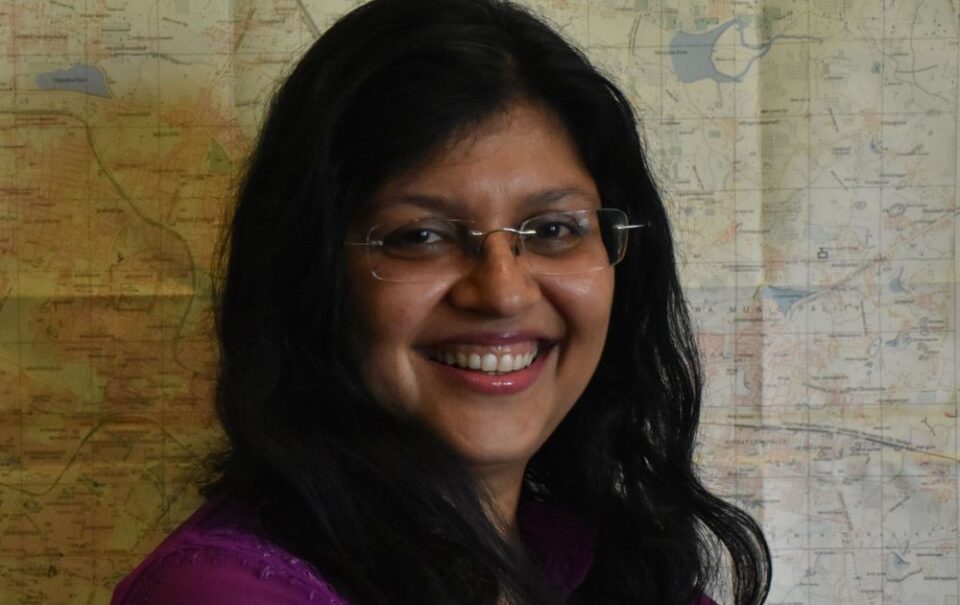BY SURABHI KAUSHIK
Harini Nagendra is a professor of ecology at Azim Premji University, a public speaker and writer on issues of nature and sustainability. Her non-fiction books including Nature in the city: Bengaluru in the past, present and future are widely read. Her debut crime fiction novel The Bangalore Detectives Club was published in 2022, and the sequel Murder Under a Red Moon was released this year. Here is a sneak peek into her fiction writing process.
What inspires you to write historical crime fiction?
Appreciating the past is essential for us to understand the present, and think about where we seem to be headed in the future. Historical non-fiction is very important to develop a scholarly perspective, but it is fiction that gets us into the past. So much of my academic research is on old Bangalore/Bengaluru, and I knew I wanted to write a book set in this time and setting, which I love so much. Crime and mystery fiction has been a first love of mine since I was very young – so it was very natural for me to immediately think of writing a historical crime novel.
Was the writing process of your second fiction novel any different from your first and how?
It was much easier in many ways. The first book’s journey, from initial idea to publication took fourteen years. During this process, I discovered how I write books, what voice works for me, how to get from the start of the plot to the finish line, and got to know each of my characters well. I fell into writing the second book much more easily, as it felt like a return to a family of people I knew and loved so well.
In both your fiction novels, the city of Bengaluru is also a character. Tell us about it.
Bengaluru/Bangalore is my favorite city, and the early 20th century is perhaps my favorite time period to look at the city. It’s a cosmopolitan, welcoming place – which has people with diverse faiths and religious beliefs, from different races and speaking different languages, coming together to create new ventures and collectively manage the city’s fortunes. The British empire governs the city’s cantonment area, while the Mysore Maharaja manages the fortunes of the pete, and the Indian parts of the city. The wooded streets and parks shine like emeralds, and the lakes with their thriving wetlands, and the communities that inhabit these spaces – the fishers, grazers, potters and cart-drivers – interacting with the new mill and industrial workers – in fascinating and varied ways. The city is a character, and justice and equity in the city play a major role in all the novels of The Bangalore Detectives Club. Kaveri is a young woman with very firm, emancipatory beliefs – her firm desire to see justice triumph over evil is perhaps only possible in a city like Bangalore, and in the times of the 1920s, where the winds of change are really visible.
I love the descriptions of your settings in both your fiction novels. Is there a specific technique you use while you write about them?
Thank you! I have worked on the ecological setting of old Bangalore for close to 18 years now, poring over maps, archival documents, photographs and other documents so much that they have soaked into my senses. The old city is really such a favorite. I often take out an old photograph of the part of the city where I set a scene, and look at it on the map. Then I close my eyes, and imagine being there, walking the streets with Kaveri and her friends, soaking in the smells and sounds – and open my eyes and write.
Do you have a favorite historical crime fiction novel?
Too many to list! But some of them include Agatha Christie’s Miss Marple books and Patricia Wentworth’s Miss Silver series, Sujata Massey’s Perveen Mistry books, and Vaseem Khan’s Malabar House books. Ellis Peters Brother Cadfael series, too.
What advice would you give to someone who is new to writing fiction?
Keep writing! It is important to get writing inputs, read books about writing, take classes, and plan ahead. But the most important thing is to figure out how you function as a writer. The only way to do that is by writing, and pushing through till you get from start to finish. And then writing again. It’s an activity where practice really makes perfect.
What are you working on next?
I’m writing book 3 in the Bangalore Detectives Club series right now. The book is set in January 1922, just before Edward, Prince of Wales, visits Bangalore. This visit is just after the large-scale protests, boycotts and strikes organized by Gandhiji and the Indian Congress in Bombay, Madras and Calcutta – the police, led by Inspector Ismail, are afraid of violence erupting in Bangalore. Meanwhile, a traveling circus visits the city, and a famous magician mysteriously disappears in the middle of a performance. Kaveri gets pulled into investigating his disappearance – in the backdrop of increasing calls for women’s suffrage, and secret meetings of the independence movement. It’s a far more complex plot, and it’s been a fascinating experience, deep-diving into the research for each of the various plot strands that make up this book.





